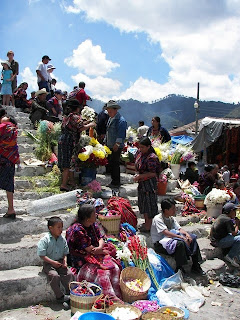Almost 30,000 miles of concrete, asphalt, clay, gravel, dirt and of course mud make up the Pan-American Highway, spanning two continents and stretching from Alaska to Chile. Only the brave walk or bike across the Highway’s only break, the Darien Gap separating Panama and Colombia.
Finally the stretch of highway was complete: four lanes of concrete shadowed by frighteningly vertical walls of earth carved out of the mountain sides. The completion of the road construction between Guatemala City and Quetzaltenango was followed by almost two months of blissful, smooth traveling, save of course for the erratic driving, shoddy vehicles, black exhaust reminiscent of LOST’s smoke monster, and of course the colorful turbo charged “chicken buses” ruling the roads.
Then came the rainy season… This season’s surplus of rain tore down the fresh walls of earth. Thankfully the extra two lanes give Guatemalans a place to store all the dirt! Makeshift signs and oddly damaged painted barrels direct traffic through the winding highlands. Every 100 meters or so traffic switches from the west bound lanes to the east bound lanes and then back. A barrel with a left or right pointing arrow indicates when to change lanes. A barrel with an upward pointing arrow is the sign to get over in the right lane because oncoming traffic will soon be in the left. Occasionally a buckled over barrel will be so damaged that you can’t quite make out the arrow. In this case, be ready for anything!
All the back and forth, it can be easy to lose track of whether your two lanes are travelling in the same direction or if you should expect a bus barreling at you around the next curve. Ideally, occasional ¡doble via! (two way) signs keep drivers on track, but if all else fails, stay in the right lane!
Then again, the right lane is often occupied by heaps of dirt, boulders, an occasional mud pond, and trees, which if they fell properly, appear to have always belonged in the lanes of the Pan-American Highway. Some of these obstacles are marked with an arrow; however, the arrow is literally on the obstacle so if you see the sign, you have hopefully already seen the massive boulder staring you in the face. A broken down motorist will at least pluck tree branches and put them in the road to warn others of his presence on the road. Yes, branches. No orange cones or flashy triangles. Branches are easy and readily available. If need be, go for the bushy green ones. Anyway, the lack of warning for the mudslide obstacles makes the left lane look pretty desirable, so if all else fails, stay in the left lane.
Do you understand why driving the Pan American Highway in Guatemala right now can be entirely confusing and maybe a little terrifying? Throw in high fog and things can get real messy.
The highway has been made manageable as a result of man power, the extra space offered by the new road, barrels and barely legible signs. However, the mudslides covering the roads claimed lives and the resulting difficulty of travel has tightened the strangle hold on Guatemalans’ finances, particularly exacerbating the already impoverished highland Maya. The chaos of the Pan American Highway in Guatemala is comical in its absurdity but the reality is disastrous and appalling.




